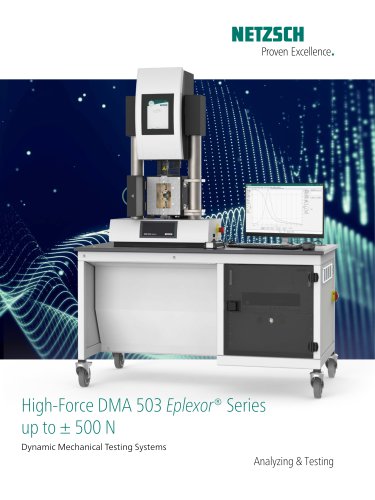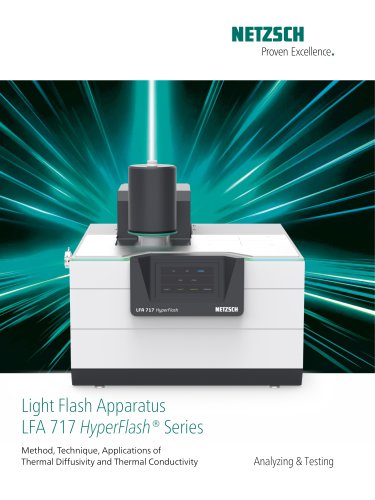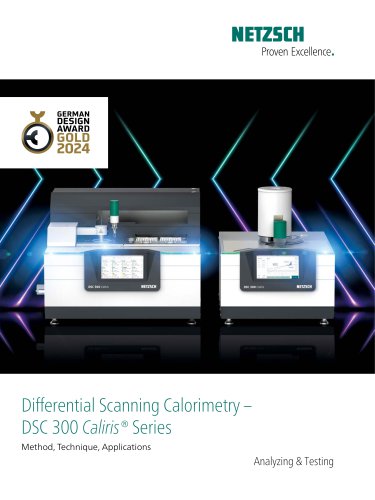 Website:
NETZSCH Analyzing & Testing
Website:
NETZSCH Analyzing & Testing
Group: NETZSCH
Catalog excerpts

Dynamic Mechanical Analysis DMA 303 Eplexor® Method, Technique, Applications Analyzing & Testing
Open the catalog to page 1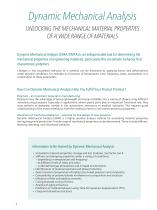
Dynamic Mechanical Analysis UNLOCKING THE MECHANICAL MATERIAL PROPERTIES OF A WIDE RANGE OF MATERIALS Dynamic Mechanical Analysis (DMA/DMTA) is an indispensable tool for determining the mechanical properties of engineering materials, particularly the viscoelastic behavior that characterizes polymers. Changes in the viscoelastic behavior of a material can be measured by applying forces and deformations under dynamic conditions, for example, as a function of temperature, time, frequency, stress, atmosphere, or a combination of these parameters. How Can Dynamic Mechanical Analysis Help You...
Open the catalog to page 2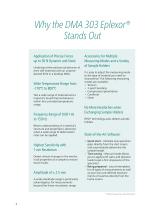
Why the DMA 303 Eplexor® Stands Out Application of Precise Forces up to 50 N Dynamic and Static Understand the mechanical behavior of even stiff materials with an unprecedented 50 N in a desktop DMA. Wide Temperature Range from -170°C to 800°C Test a wide range of materials and a material‘s broad thermal behavior within this unrivaled temperature range. Frequency Range of 0.001 Hz to 150 Hz Better understanding of a material‘s structure and properties is obtained when a wide range of deformation rates can be applied. Highest Sensitivity with 1-nm Resolution Detect minute changes in the...
Open the catalog to page 4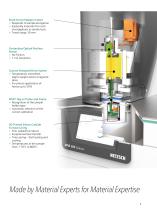
Static Drive (Stepper motor) Responds to sample elongation Especially important for such investigations as tensile tests Travel range: 30 mm Contactless Optical Position Sensor No friction 1-nm resolution Custom-Designed Drive System Temperature-controlled, leight-weight electro-magnetic drive For precise application of forces up to 50 N RFID* Tag on Probe and Frame Recognition of the sample holder type Automatic selection of the correct calibration 3D-Printed Silicon Carbide Furnace Lining Thin-walled but robust Exceptional heat transfer Time-saving – fast heating and cooling Temperatures...
Open the catalog to page 5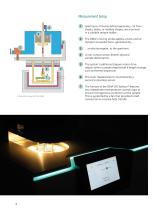
Specimens of clearly defined geometry, cut from sheets, plates, or molded shapes, are mounted in a suitable sample holder. The DMA‘s moving probe applies a static and/or dynamic sinusoidal force, generated by ... A non-contact sensor detects dynamic sample deformation. The system‘s additional stepper motor drive adjusts when a sample experiences a length change, such as thermal expansion. This static displacement is monitored by a second contactless sensor. The furnace of the DMA 303 Eplexor® features two independent temperature control loops to ensure homogeneous conditions at the sample....
Open the catalog to page 6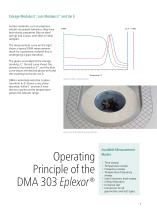
Storage Modulus E’, Loss Modulus E’’ and tan δ Certain materials, such as polymers, exhibit viscoelastic behavior; they have both elastic properties (like an ideal spring) and viscous ones (like an ideal damper). The measurement curve on the right shows a typical DMA measurement result for a polymeric material that is undergoing a glass transition. The green curve depicts the storage modulus, E’, the red curve shows the dynamic loss modulus, E’’, and the blue curve shows the derived phase shift and the resulting loss factor, tan δ. DMA is extremely sensitive to glass transition as E’ shows...
Open the catalog to page 7
Advanced Instrument Design Offering Flexibility and Convenience The unique suspended and moving sample holder of the DMA 303 Eplexor® arranged below the measuring system prevents contamination from falling sample fragments and allows easy and safe sample handling. We Take Care of All Users Clear View The height-adjustable measuring head accommodates for different users' heights or preferences for standing or sitting, offering optimal comfort during use. The illuminated sample holder area makes it easy to set up samples and geometries. This, in combination with heightadjustable sample...
Open the catalog to page 8
IMPROVED STATUS INFORMATION – EVEN FROM AFAR Get complete insights into your measurements with the DMA 303 Eplexor®. Our advanced instrument offers a comprehensive overview of your current measurement on the built-in display. The innovative LED status bar allows you to check the general instrument status of the instrument even from afar. The integrated color display provides real-time updates on important information, such as: Measurement progress Temperature Force Frequency No more time-consuming logging into your PC – the information is right there. Visual support when changing sample...
Open the catalog to page 9
EFFECTIVE CHOICE OF COOLING SYSTEMS Smart and Economical Cooling Solution for Your LowTemperature Experiments Many applications, such as low-stiffness polymers, require a measurement start below room temperature. Air Chiller System The AIC 80 cooling system is a compact air intracooler that operates entirely without liquid nitrogen. It is a compact cooling unit based on a heat exchanger system with a long insulated connection line, allowing the air intracooler to be placed under the table or on the side, whichever is most convenient in your laboratory. The valve is software-controlled and...
Open the catalog to page 10
NETZSCH offers a wide variety of sample holders for its DMA 303 Eplexor®. This results in optimal adaptation of the test conditions to the sample size and stiffness, as well as to the application. For example, a different sample holder is needed to measure a thin polymer film versus a stiff material such as a fiber-reinforced composite. RFID* tag for automatic sample holder recognition Grooves supporting toolless installation Fixture guides supporting correct insertion of sample holder The latest generation of NETZSCH DMA sample holders feature a low-mass design. There is a choice of...
Open the catalog to page 11
Clamping Systems to Suit Your Every Need Tension sample holder This sample holder is perfect for solid materials. The sample doesn't suffer from clamping effects and results are therefore ideal. The three-point bending tool is equipped with self-adjusting outer sample supports. This allows for good results to be achieved even on slightly warped samples. Tensile clamps are commonly used for films and fibers. With a force up to 50 N, even strips of moderately stiff materials can be measured. Specimens are fixed with only one screw, ensuring evenly distributed clamping pressure. Laser-etched,...
Open the catalog to page 12All NETZSCH Analyzing & Testing catalogs and technical brochures
-
LFA 717 HyperFlash® Series
28 Pages
-
DSC 300 Caliris Series
28 Pages
-
STA 509 Jupiter Series
28 Pages
-
TG 309 Libra Series
24 Pages
-
DEA 288 Ionic
20 Pages
-
STA 2500 Regulus
12 Pages
-
NTA Guarded Hot Plate Series
16 Pages
-
TMA 402 F1/F3 Hyperion®
16 Pages
-
Rosand Series
20 Pages
-
Accelerating Rate Calorimetry
20 Pages
-
NTA HotBoxes
16 Pages
-
DIL 402 Expedis Select/Supreme
28 Pages
-
DIL 402 Expedis Classic
16 Pages
-
Product Overview
12 Pages
-
NETZSCH Energy Solutions
40 Pages
-
Advanced Materials Testing
32 Pages
-
NTA Fire Testing Systems
20 Pages
-
Kinetics NEO
20 Pages
-
TG-FTIR - product brochure
24 Pages
-
TA-QMS Coupling
28 Pages
-
Kinexus Prime DSR Series
20 Pages
-
Kinexus Prime Series
20 Pages
-
HMOR 422
1 Pages
-
RUL/CIC 421
1 Pages
-
Cone Calorimeter TCC 918
12 Pages
-
Thermal Insulation Materials
24 Pages
-
SBA 458 Nemesis®
24 Pages
-
NETZSCH NEVIO Instrument Series
24 Pages
-
LFA 427 - product brochure
24 Pages
-
DMA GABO EPLEXOR up to 1500°C
12 Pages
-
GABOMETER®
8 Pages


